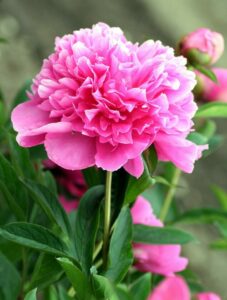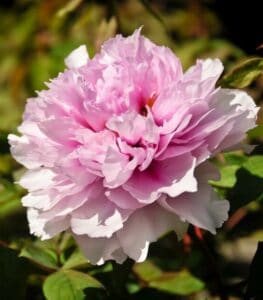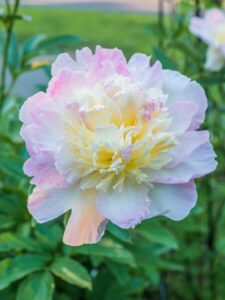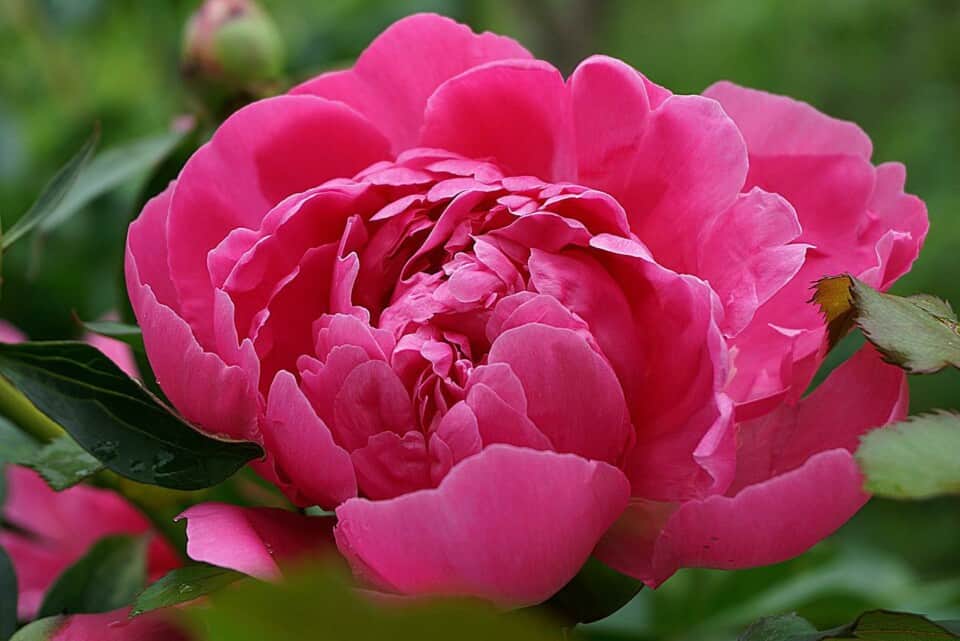Some links in the post are affiliate links and I get a commission from purchases made through some links found in the post.
Do you want to know the easiest way to gauge if your peony gets enough light? Look at how it flowers. Does it have large and colorful blooms that light up your space?
Do its blooms spruce up your home in spring and summer? Or does your plant produce minimal to no flowers? If your answer is the latter, lighting could probably be the issue.
Of course, we would not want to stick with poor lighting as the only answer – factors like underfeeding, underwatering, and unsuitable temperatures can also be to blame.
But if you can vouch for all the other factors, you might want to pay more attention to the lighting in your home.
The light depends on the type of peony. The herbaceous and perennial peonies do best in at least 8 hours of bright and direct sun (full sun).
The tree and shrub peonies do best in at least 6 hours of bright and indirect light. Finally, the Itoh and intersectional peonies do best in at least 8 hours of bright and direct light.
This guide takes you through how much light your peony needs (considering each species as an individual), how to know your peony needs more or less light, and where to place your peony to give it a better chance of survival.
And if your home does not get enough light, I have also included how you can get your peony to bloom using artificial lighting.
Let’s do this:
What Type of Light Does My Peony Need?
 Peonies, which are from the genus Paeonia, feature about 30 species known for their ease of propagation and beauty.
Peonies, which are from the genus Paeonia, feature about 30 species known for their ease of propagation and beauty.
Owing to the difference in species, the native habitats also differ. Some originate from Europe, others from Asia and a good number from North America.
Most of these come from the northern hemisphere, where they thrive in cold temperatures. As a result, most of them can survive in hardiness zones 3 to 9.
And if you’ve paid attention to the USDA hardiness zones, you know that 3 to 6 have quite cold climates. Yet, most peony species can do well in these conditions. That tells you a lot about their lighting preferences.
Of course, not all peonies can survive temperatures as low as those in zones 3 and thereabout. Instead, it comes down to their growth habits. But what are these?
1) Herbaceous Peonies/ Perennial Peonies
Most people have these in their homes. They feature herbaceous stems on which flowers bloom for a few weeks.
A unique feature about these species is their foliage which turns golden in the fall before dying once the first frost hits. Caring for these peonies is easy and quite rewarding as they can live for more than 3 decades.
The herbaceous and perennial peonies are light-loving plants and thus do best when left in the full sun/ bright and direct light. Under these conditions, they produce a lot of flowers.
2) Tree Peonies/ Shrub Peonies
These peonies grow much larger than the perennial types and thus produce more flowers each year. Moreover, their blooms last longer.
While the foliage of the perennial peonies dies back after the first frost, that is not always the case with these plants. Instead, the leaves can remain on the tree if the temperatures remain favorable.
While you would think that these would be the hardiest of all the peonies, these plants are a bit different. They enjoy bright and direct light in the spring.
But once they start flowering, the tree and shrub peonies prefer bright and indirect light. The direct sun damages their flowers and reduces the bloom time.
As such, rather than lasting two weeks, the flowers can last a few days before dying. They thus need partial shade/ partial light when blooming.
3) Itoh Peonies/ Intersectional Peonies
What do you get when you combine shrub peonies with perennial peonies? If your guess was Itoh peonies, you are right on the money.
These hybrids bloom later in the season. But on the upside, their blooms last a month on average.
So, what kind of light should you give the Itoh and intersectional peonies? Bright and direct light! When placed in full sun, these peonies use the light to make enough food to produce healthy blooms.
Moreover, being in the direct sun also enables them to flower for a more extended period.
Above, you may have noticed the use of terms like bright, direct, indirect, etc. What do these mean, and why do they matter? Light types differ based on how the sun’s rays hit the plant. They come down to:
- Bright and Direct Light/ Full Sun: If you stand outside on a sunny day and the sun’s rays hit you, you receive bright and direct light. That is akin to what a peony would receive in its native habitat in the outdoors.
- Bright and Indirect Light: Now assume you stand outside on a sunny day but between taller plants than you. What you would receive would be partial shade/ partial sun. Sometimes, this type of light also goes by dappled light/ filtered light. Under this light, a plant does not get hit by direct sun rays, protecting its flowers from getting damaged.
For the most part, all peonies prefer bright and direct light during the growing season. Itoh and herbaceous types also thrive in this light, even when flowering. But tree peonies prefer bright and indirect light once they flower.
You may also like: What soil should you use for your peony
How Much Light Does A Peony Need?
The more light a peony receives, the easier it is for the plant to make enough food to sustain its blooms. Below is what each variety needs:
1) Herbaceous Peonies/ Perennial Peonies
Herbaceous and perennial peony plants need at least 8 hours of bright and direct light a day. They do not suffer adverse effects owing to too much sun exposure. If anything, the more light they get, the better they bloom.
2) Tree Peonies/ Shrub Peonies
Tree and shrub peonies enjoy bright and direct light all day in the active growing season. But when they start flowering, they require bright and indirect light at least 6 hours a day.
Note, though, that the blooms last two weeks on average. As such, these plants are best placed in positions where they can access full sun for most of the year.
3) Itoh Peonies/ Intersectional Peonies
Like perennial peonies, a full day exposure to bright and direct light does these plants a lot of good.
It encourages them to flower more and even sustain their blooms for much longer. At least 8 hours of light should be sufficient for the Itoh and intersectional peonies.
Working with the 8-hour minimum (regardless of the type of light) should be a good yardstick in this case.
You may also like: What are the common peony problems
What Happens If Your Peony Gets Too Little Light?
It’s already clear that these plants enjoy basking in adequate lighting. So, you can imagine that things would fall apart if they did not get their daily dose of sunshine. What signs should you look for in your peonies?
1) Minimal or No Flowering
 With peonies (known for their colorful blooms), lack of or minimal flowering is a dead giveaway that something is amiss.
With peonies (known for their colorful blooms), lack of or minimal flowering is a dead giveaway that something is amiss.
Your peony needs light to make food which gives it the energy to give rise to those fantastic flowers.
But if the light is insufficient, your plant will not bloom. Herbaceous and Itoh varieties must get bright and direct light throughout the blooming season to keep producing flowers.
And for the shrub varieties, ensure the plant receives full sun before blooming, then cut back to bright and indirect light during the flowering season.
If your plant gets enough light and still does not bloom, consider its feeding schedule, the favorability of your climate, and the plant’s age.
2) Leggy Growth
Another tell that your plant needs more light is leggy growth. A plant that gets enough bright and direct light grows upwards and outwards.
But if your plant only grows upwards and does not have corresponding foliage production, you can tell it’s trying to reach for the light.
Its stems will be long and weak, and its internodal spaces will be longer than usual. I will take you through how to position your peony to avoid such an outcome.
3) Poor Foliage Production
While peonies are known for their beautiful flowers, their leaves are also part of their allure. And for most of the year, that is all you have to admire as you await the blooms.
If you notice that the new leaves are smaller and weaker than the older ones, it’s a sign of poor lighting. Your peonies are not getting enough light to produce the sugars necessary to support healthy foliage development.
4) Change in Leaf Color
Peonies boast vibrant foliage when they get enough light exposure. So, if this changes to a pale yellow, you will know that your plant is not making enough chlorophyll to keep its foliage green.
5) Stunted Growth
During active growing months, you should notice a change in your plant’s size.
But if it seems to be growing slowly or not at all, that’s a sign that it lacks the energy to promote healthy development. And the best way to deal with this is by increasing its light exposure.
Please note that some of the problems above may point to other issues. For example, if you underfeed your plant, you may notice that its growth has slowed down.
When fixing lighting issues, consider what else could be fueling the problem at hand so you can give your plant a decent chance of blooming.
You may also like: 6 reasons why your peony is curling and 5 reasons why your peony is drooping
What Happens If Your Peony Gets Too Much Light?
Too much light is hardly ever a problem. If anything, herbaceous and Itoh peonies enjoy bright and direct light and thrive in such conditions.
But with the shrub peony, you need to be more careful during the flowering season. Its blooms are highly sensitive to the sun.
And if they get direct sun exposure, they fall off within a few days, robbing you of the chance to have the blooms longer.
Seeing as the bright and indirect light is only necessary for a few weeks in the year, it’s best to install a shade cloth when the plant starts flowering.
After the season ends, you can take it off and allow the plant to grow in the direct sun.
Where To Place Your Peony to Get The Best Light
Peonies love light, and that makes it easy to locate them. After all, you can plant them outdoors in the sun’s full glare, and they will not die.
However, this only applies to Itoh and perennial varieties. So, let’s figure out where you can place each peony:
Herbaceous Peonies/ Perennial Peonies and Intersectional Peonies/ Itoh Peonies
These sun-loving varieties should be towards the south of your garden. That way, they can receive bright and direct light most of the day. You don’t need to add protection to keep them safe. This way, they can grow healthy and bloom with grace.
Tree Peonies/ Shrub Peonies
These plants do well in bright and direct sun most of the year. However, when they flower, they don’t take too well to this kind of lighting. So, you have two choices when planting them:
1) You can place them towards the east of your garden: The morning sun is not as harsh as the afternoon sun.
That way, the plant can enjoy some gentle morning sun and remain shielded from the afternoon sun as the sun sets.
Please note that this only works if there’s an object that protects the plant in the afternoon. Otherwise, it will receive morning and afternoon sun, damaging its flowers.
2) You can leave the plant in the east or south of your garden most of the year. Then when it starts flowering, you can shade it with a cloth to protect its flowers.
Would other lighting conditions work? Probably not – peonies love bright and direct light and will not bloom well in low light. So, what should you do if the lighting in your garden is not enough?
You may like: Do peonies bloom more than once
Can Peonies Grow in Artificial Light?
You can grow peonies in artificial lights! Peonies love bright and direct light. And you can get this from the sun or invest in artificial lights that have the same effect.
How To Grow a Peony Using an Artificial Light
 You will need to move your peony indoors, where you can leave it under a full spectrum light.
You will need to move your peony indoors, where you can leave it under a full spectrum light.
This light has red and blue wavelengths that promote flowering and foliage development, respectively. With peonies, red wavelengths are non-negotiable. Else, you must give up the blooms.
Full-spectrum lights mimic the kind of light that the sun would emit at noon, so their effectiveness is relatively high. Choose among the following lights:
- LEDs: These emit low heat and can be 6 inches above the peony.
- Fluorescents: These lights should be at least 6 inches away from the plant.
- Incandescent Lights: These should be 24 inches above the peony due to their high heat emission.
- Halogen Bulbs: These should be 24 inches above the peony.
You can also consider HID lights which are just as effective as fluorescent lights and need a similar amount of spacing.
In all these cases, you should leave the lights on for at least 10 hours a day and adjust the timing as needed, based on seasons.
Also, you will need to increase the spacing between the light and the plant during the flowering season for shrub peonies.
You may also like: 8 reasons your peony plant is turning brown
Final Thoughts
Would you ever have guessed that lighting alone could heavily influence flowering in your peony? Well, it does. But luckily, you now know that your plant loves light, and you can leave it in the sun all day. Happy Gardening!


